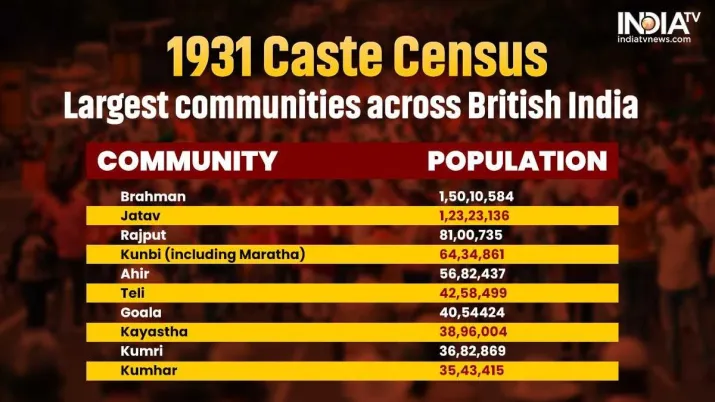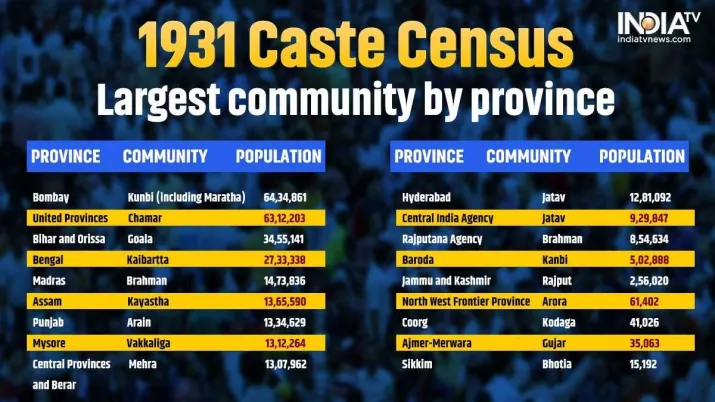As the government prepares to include caste enumeration in the upcoming national census, it revives memories of the last full-fledged caste census which was conducted way back in 1931. The census, conducted under British rule, was the last official enumeration that recorded caste-wise data.
In a significant move, the Central government on Wednesday announced its decision to incorporate caste-based data collection in the upcoming nationwide census. The development came following decisions taken by the Cabinet Committee on Political Affairs. Addressing a press conference, Union Minister Ashwini Vaishnaw said the inclusion will be carried out in a transparent manner, marking a major policy shift that could reshape social and economic policymaking in the years ahead.
He said the census is a central subject, yet several states, primarily governed by opposition parties, have carried out their own caste surveys, often with political motivations. He emphasised that the Prime Minister Narendra Modi-led government is committed to conducting caste enumeration at a national level with complete transparency and fairness. The nationwide census, originally scheduled to begin in April 2020, was postponed due to the outbreak of the COVID-19 pandemic.
As the government prepares to include caste enumeration in the upcoming national census, it revives memories of the last full-fledged caste census conducted nearly a century ago — in 1931. That historic exercise, undertaken during British colonial rule, still casts a long shadow on the country’s socio-political fabric.

Significance of 1931 caste cenus
According to reports, the 1931 Census was only the second to count castes, following a similar attempt in 1901. It provided critical insights into the composition of Indian society at the time. One of the most significant takeaways was the estimate that Other Backward Classes (OBCs) made up 52% of India’s then population of 271 million (27 crore). This single data point later became the backbone of the Mandal Commission’s 1980 report, which famously recommended 27% reservations for OBCs in government jobs and educational institutions — a policy that was finally implemented in 1990.
It is said that conducting such an exercise was not without its challenges then. The earlier censuses saw frequent methodological shifts. For instance, in the 1881 Census, only caste groups with more than one lakh members were documented. By 1901, under Census Commissioner HH Risley, the system pivoted to a varna-based hierarchy, sparking widespread resistance from various castes eager to improve their social standing through official categorisation.

What is a caste census?
A caste census involves the systematic collection of data on caste identities during the national population count. In a country like India, where caste plays a central role in shaping access to education, jobs, and social capital, such data helps policymakers assess the demographics, economic status, and representation of various communities. These insights are crucial in formulating reservation policies, welfare schemes, and social justice programs.
Why was it discontinued?
After independence, the then Nehru government chose to discontinue caste enumeration, arguing that it could undermine national unity and deepen societal divisions. It is said that the sheer diversity of castes and sub-castes across regions also made the process administratively complex. Hoever, post-independence leaders aimed to reduce caste-based identities and strengthen a unified national identity.
Why is caste census needed now?
Over the past few decades, growing social inequalities and mounting political demands have reignited calls for a caste census. Here’s why it has gained renewed urgency:
- Social justice: Accurate caste data can enhance the effectiveness of reservation policies in education, jobs, and welfare programs. It can help identify marginalised groups more precisely and ensure they receive rightful support.
- Policy reform: According to Poonam Muttreja, Executive Director of the Population Foundation of India, a caste census can expose disparities in education, healthcare, nutrition, and social security—thus aiding the creation of more inclusive and responsive policies.
- Political representation: Reliable caste data allows political parties to assess representation gaps among communities and refine their electoral strategies accordingly.
- State-level demand: States like Bihar and Telangana have already conducted their own caste surveys, outlining the practical value of such data and triggering a demand for a nationwide exercise.
- Socioeconomic disparities: Caste continues to impact access to opportunities and resources. Without concrete data, designing effective, targeted policies remains a challenge.
The challenges ahead
Despite its importance, implementing a caste census is fraught with challenges. India’s vast diversity — with thousands of castes and sub-castes — makes classification and standardisation extremely complex. Critics also fear the risk of deepening social divides or reinforcing caste identities. Past experiences, such as the limited use of data from the 2011 Socio-Economic and Caste Census (SECC), also raise concerns about practical implementation. However, with careful planning and a transparent approach, these hurdles can be turned into opportunities. The exercise, if executed responsibly, could strengthen inclusive governance and empower marginalised communities.
ALSO READ: Modi govt to conduct ‘caste census’ in India, cabinet to include caste enumeration in exercise


